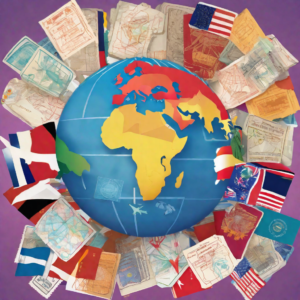Introduction to Transit Visas

Transit visas play a crucial role in international travel, allowing travelers to pass through a country on their way to a final destination. Understanding the concept of transit visas is essential for smooth and hassle-free travel. In this article, we will explore the definition and purpose of transit visas, differentiate them from tourist and entry visas, and discuss common transit visa requirements.
1. Understanding the Concept of Transit Visas

A transit visa is a travel document issued by a country to allow travelers to transit through its territory for a specified period. It is typically granted when the traveler’s final destination is in a different country. The purpose of transit visas is to ensure that travelers can pass through a country without any intention to stay or engage in activities other than transit.
Differentiating transit visas from tourist and entry visas is important. While tourist visas are for travelers who plan to stay in a country for leisure purposes, transit visas are merely for passing through the country. Entry visas, on the other hand, are required when the traveler intends to stay in a country for an extended period or engage in activities beyond transit.
Common transit visa requirements vary from country to country but often include valid travel documents, evidence of onward travel, and proof of sufficient funds for the duration of transit.
Benefits of Obtaining a Transit Visa

Obtaining a transit visa comes with numerous benefits that can enhance the overall travel experience. Let’s explore some of the advantages travelers can enjoy by securing a transit visa.
1. Exploring the Freedom of Transit
Having a transit visa allows travelers the freedom to explore and make the most of layovers or stopovers during their journey. Instead of being confined to the airport, travelers can step out and experience a taste of the country they are transiting through. Whether it’s visiting popular landmarks, sampling local cuisine, or immersing oneself in the culture, transit visas offer an exciting opportunity for sightseeing and exploration.
2. Utilizing Layovers for Sightseeing and Exploration
Layovers are an inevitable part of long journeys, and having a transit visa can transform them into memorable experiences. Rather than spending hours waiting at the airport, travelers with a transit visa can venture out and make the best use of their time by exploring the city or nearby attractions. This not only breaks the monotony of travel but also adds a touch of adventure and excitement to the journey.
3. Avoiding Potential Travel Delays and Issues
Obtaining a transit visa in advance helps to avoid potential travel delays and issues. Without a transit visa, travelers may be denied entry into a country or be forced to remain within the confines of the airport. This could lead to unnecessary worry and tension.. By securing a transit visa, travelers can ensure a smoother transit experience, minimizing the risk of travel disruptions and delays.
Factors Influencing Transit Visa Processing Times

Transit visa processing times vary depending on several factors. It is important for travelers to be aware of these factors to better understand the timeline for obtaining a transit visa.
1. Regional Variations in Processing Timelines
Different regions have their own set of rules and regulations when it comes to transit visas. As a result, processing timelines can vary significantly. It is advisable to gather information about the specific region or country’s transit visa processing times before planning a journey.
2. Impact of the Traveler’s Nationality
The nationality of the traveler can have an impact on transit visa processing times. Some countries have agreements with certain nations, allowing for expedited processing or even waiving the need for a transit visa altogether. However, for travelers from countries with stricter visa requirements, the processing times may be longer.
3. Transit Visa Application Volume and Peak Travel Seasons
The volume of transit visa applications can affect processing times, especially during peak travel seasons. Increased demand for transit visas can lead to longer processing times as immigration authorities focus on a higher number of applications. Travelers should consider this factor while planning their transit visa application to avoid any potential delays.
Detailed Timeline of Transit Visa Processing
- Processing Times for Canadian Transit Visas: Canada offers transit visas known as Transit Without Visa (TWOV) and China Transit Program (CTP). The processing time for these visas is typically around five to ten business days. It is advisable to apply early to allow sufficient time for processing.
- Transit Visa Exception Programs for Specific Nationalities: Some nationalities are exempt from transit visa requirements under specific programs. For example, the Visa Waiver Program allows citizens of certain countries to transit through the United States without a visa. Travelers should check the official websites of relevant immigration departments for the most up-to-date information on these programs.
Best Practices and Tips for Smooth Transit Visa Applications

Applying for a transit visa can be a straightforward process if certain best practices and tips are followed. Here are some guidelines to ensure a smooth transit visa application experience.
1. Plan Ahead: Knowing When to Apply for a Transit Visa
- Recommended Timeframes for Transit Visa Applications: It is advisable to apply for a transit visa well in advance, generally around four to six weeks before the intended travel date. This allows sufficient time for processing and accommodates any potential delays.
- Acknowledging Potential Processing Delays and Emergencies: Travelers should be prepared for potential processing delays or emergencies that may arise during the transit visa application process. Allowing ample time for unexpected situations ensures a stress-free travel experience.
- Strategies for Expediting Transit Visa Processing: Some countries offer expedited processing options for an additional fee. If the travel plans require urgent transit visa processing, it may be worth considering these options to expedite the application process.
2. Ensuring Correct and Complete Documentation
- Understanding Required Documents for Transit Visa Applications: Familiarize yourself with the required documents for transit visa applications. This includes valid travel documents, proof of onward travel, and evidence of financial stability. Ensuring the correct and complete documentation can expedite the processing time.
- Tips for Organizing and Presenting Supporting Documents: Organize supporting documents in a clear and concise manner to streamline the application process. Use folders or envelopes to keep documents organized and submit them in the requested format, such as photocopies or scanned copies as required.
- Navigating Language and Translation Requirements: If the supporting documents for the transit visa application are in a language other than the official language of the country, it may be necessary to provide translations. Ensure that translations are accurate and done by a certified translator, if required.
3. Seeking Professional Assistance for Transit Visa Applications
- Utilizing Travel Agents and Visa Specialists: Travel agents and visa specialists can provide valuable assistance in navigating the transit visa application process. They are well-versed in the requirements and can offer guidance and support throughout the application process.
- Online Resources and Governmental Websites for Accurate Information: Online resources, including governmental websites, provide up-to-date and accurate information regarding transit visa requirements and processing times. It is essential to rely on reliable sources to ensure accurate information.
- Efficient Communication and Follow-up during the Application Process: Communication is key during the transit visa application process. Respond promptly to any requests for additional documents or information from the immigration authorities. Additionally, follow up on the application status to ensure timely processing.
Summary and FAQs
Transit visas play a crucial role in ensuring seamless travel through different countries. By understanding the guidelines and processing times, travelers can navigate the transit visa process confidently. Here is a summary of the key points discussed in this article:
- Transit visas are travel documents that allow travelers to transit through a country on their way to a final destination.
- Obtaining a transit visa offers the freedom to explore, utilize layovers for sightseeing, and avoid travel delays and issues.
- Factors influencing transit visa processing times include regional variations, the traveler’s nationality, and the volume of applications.
- Detailed timelines for transit visa processing vary in different regions, such as Europe, North America, Asia, Oceania, Africa, and South America.
- Best practices for smooth transit visa applications include planning ahead, ensuring correct documentation, and seeking professional assistance if needed.
Frequently Asked Questions
- Can I apply for a transit visa upon arrival?
While some countries may offer the option to obtain a transit visa upon arrival, it is advisable to check the specific requirements and regulations of the destination country beforehand. Applying for a transit visa in advance is generally recommended to avoid any potential complications or delays.
- Are there any countries that do not require a transit visa?
Some countries have transit visa exemption programs for specific nationalities. These programs allow travelers to transit through the country without a transit visa. However, the eligibility criteria and duration of stay vary. It is essential to check the official websites of the immigration departments for up-to-date information on transit visa exemptions.
- What happens if my transit visa application is denied?
If a transit visa application is denied, travelers should carefully review the reasons for the rejection provided by the immigration authorities. It might be possible to address any issues or rectify mistakes in the application and reapply. In case of denial, seeking guidance from a travel agent or visa specialist can be beneficial to understand the options available and the necessary steps to take.


